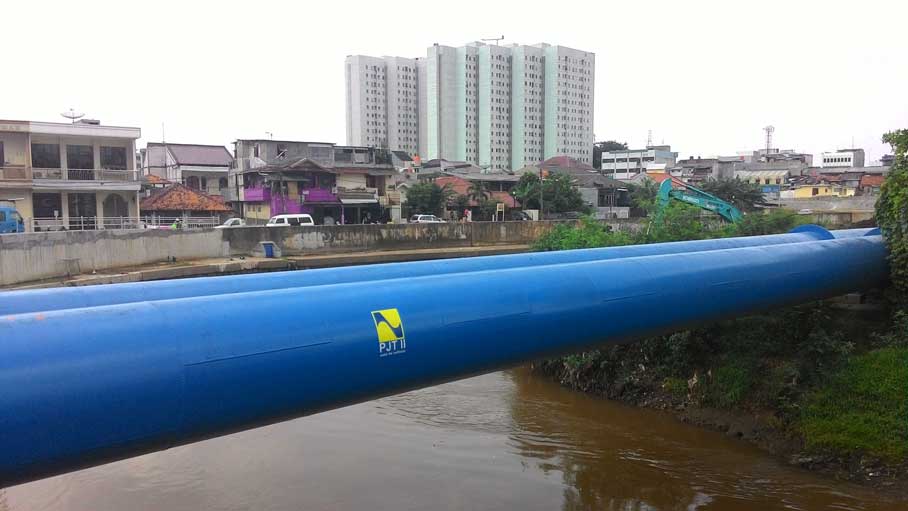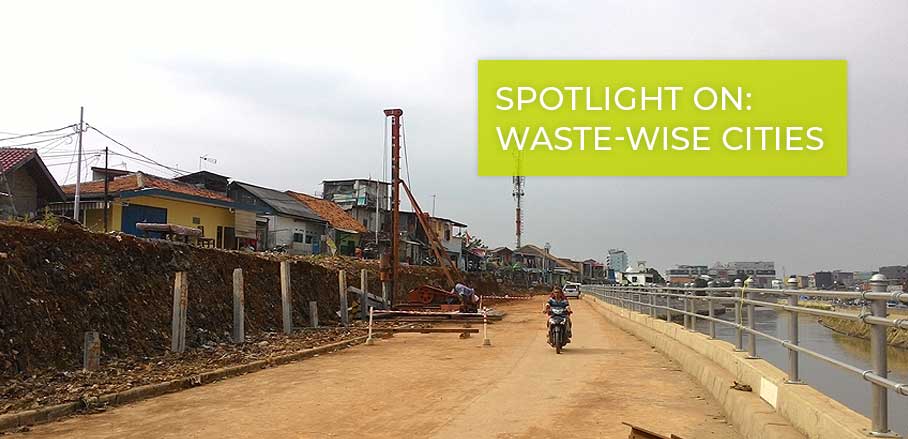The Forgotten Water – The Role of Decentralised Wastewater Management in Jakarta’s Socio-Ecological System
Jakarta has responded to regular flooding by proposing gigantic infrastructure projects such as sea walls to keep the water at bay. But the main problem is that the city does not consider the land-water ecosystem as a whole, says Prathiwi W. Putri.
A Missing Link
Jakarta has been portrayed as one of the fastest sinking cities in the world due to a high rate of land subsidence. The idea of building sea walls for coastal-flood control has been dominating the planning discourses, despite persistent critique from civil society organisations. Many have questioned the effectiveness of massive engineering undertaking to protect Jakarta, as the delta has been regularly flooded because of high precipitation and voluminous streams of water from the urbanised mountainous hinterlands, instead of from the sea.
In a low land delta, flooding is indeed part of natural processes of the coastal ecosystem, but what worsens the situation is the absence of sufficient open green space and water retention areas in the city. Flood mitigation has been a long-standing concern for the Special Capital Region of Jakarta, but so far, the conventional hard-infrastructure approach has been dominating the water sector.
One recent project to address flooding is the so-called river normalisation, another big project to make river basins ‘normal’ by aligning and strengthening the edges with concrete retaining walls, in order to immediately direct excess water to the sea.
The sea wall and river normalisation projects exemplify how the water sector development in Jakarta has been planned reactively to particular tangible problems without considering the cycle of land-water ecosystem as a whole. The focus on massive infrastructure development often misses the essence of protecting public health and community livelihoods.
Fundamentally, what has been long absent is an alternative approach to urban water management at diverse scales of social and technological interventions (at the household, building, neighbourhood, district, municipality level and so on), with techniques to slow down and retain surface water flows for groundwater recharge and water resource preservation. The great missing link for this alternative approach is proper domestic wastewater management and environmental sanitation.
The Jakarta metropolitan region is blessed with high precipitation, but it seems impossible to utilise rainwater when the flows are easily contaminated by untreated wastewater. My research conducted between 2009 and 2014 estimates that in Jakarta, 85 per cent of domestic grey water was discharged directly into the ground and water bodies, while around 60 per cent of black water was not treated, polluting groundwater and surface water bodies.
Jakarta is populated by ten million residents, three million seasonal inhabitants and part of a larger urban agglomeration called Jakarta Metropolitan Area with approximately 27 million people. By handling and treating wastewater, not only water-borne diseases will be mitigated, but cities will also tap new sources of clean water for flushing and cooling. This would mean securing a sustainable clean water provision for the metropolitan area. Currently, 80 per cent of the supply is channelled to the city from the West Java regions at the expense of agricultural needs.

Water-supply primary pipes passing over the Ciliwung river, mainly for serving formally-developed houses, offices and commercial buildings. © Prathiwi W. Putri, May 2017
“A City with Millions of Septic Tanks”
Today, the sewerage service in Jakarta covers only around 5 per cent of the city area and the network’s length has not even doubled since construction began in 1983. Outside this sewer system, various incremental solutions for handling wastewater exist, but do not necessarily comply with basic standards of environmental and personal health.
In reference to the sanitary conditions, policy makers have called Jakarta “a city with millions of septic tanks”. Using septic tanks has become the easiest solution for holding individual households’ wastewater, but for healthy sanitation, a city system should regularly empty the tank and treat the sludge properly – which often is not the case.
And the problem doesn’t stop there: most septic tanks leak, there is a lack of awareness among residents about wastewater issues, and the city’s desludging system has limited capacities.
Surprisingly, many formally-built housing estates still apply individual septic tanks without proper control on the construction and operational quality. The practices of private developers regarding wastewater handling and treatment have been under-regulated, yet the planning authority can easily issue permit for new housing estates.
Shortcomings of the City’s Master Plan
Jakarta’s latest wastewater master plan was initiated in 2010 and the draft was completed in 2012. In the new master plan, fifteen zones of sewerage networks have been proposed, with each zone having its own wastewater treatment plant. These zones are set to be implemented in three stages of development until 2050. It is estimated that in total, the off-site systems will cover 80 per cent of the Jakarta area. On-site systems will suit the remaining 20 per cent, which is occupied by slums and informal settlements. [1]An off-site system collects wastewater within a relatively large catchment area, normally using underground sewer systems, to convey wastewater into a treatment plant. On-site system means collecting and treating wastewater at the point of wastewater source.
The Master Plan can be seen as a step forward because it has considered several intervention areas, rather than a single centralised system like in the previous plans.
However, each zone still covers a relatively large area and relies on a homogenous technological system. From the 80 per cent area that is to be served by off-site systems, around 65 per cent is actually covered by residential areas that were developed in fragments with irregular physical patterns. Laying secondary and tertiary sewer grids there would be costly. It is also unreasonable to assume that communities would voluntarily connect to the sewerage networks while the necessary legal frameworks that would oblige residents to connect their properties to the grids have not been put in place.
While two zones of the Master Plan are now under construction, I would argue that the whole plan needs to be revisited. The Master Plan provides no directions for how to develop the 20 per cent area that has been identified suitable to have on-site sanitation systems. It only makes a few normative suggestions, for example that the quality of septic tanks has to be improved.
A necessary step to improve the Master Plan would be to cluster smaller areas within each zone, to incorporate diverse small-scale technologies and soft infrastructures such as green open space and natural wetlands. Within a smaller intervention area, special needs of particular communities and specific ecological-geographical context can be addressed, and technological solutions for the problems of storm-water, wastewater and drought can be provided in an integrated manner.
Many studies show that small-scale and low-cost technologies for clean water provision and environmental sanitation are often more effective in answering the needs at household and community levels. The delivery is likely more accountable, as residents can control the planning and construction processes more directly. Not only megaprojects raise an effectiveness question, they also raise an ethical question on public spending or debt in the capital city, while many other provinces suffer from underdevelopment.
